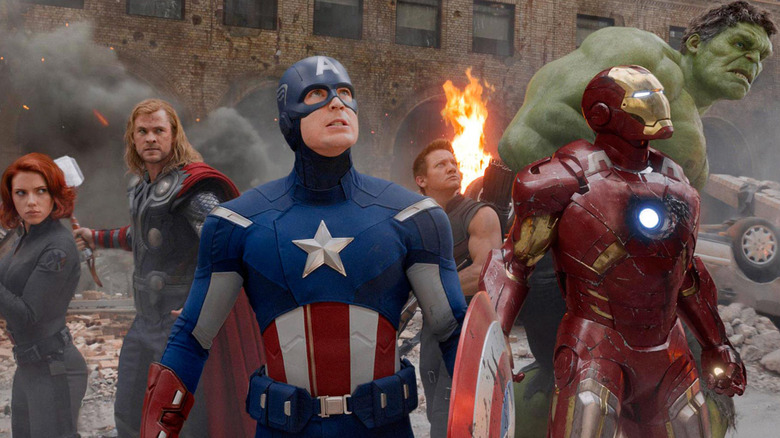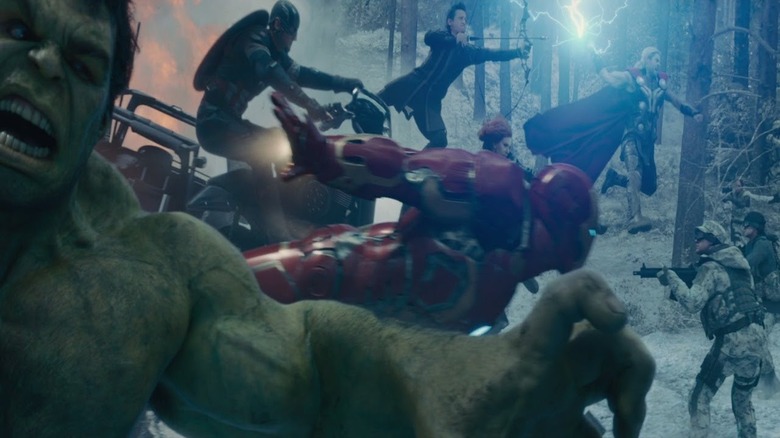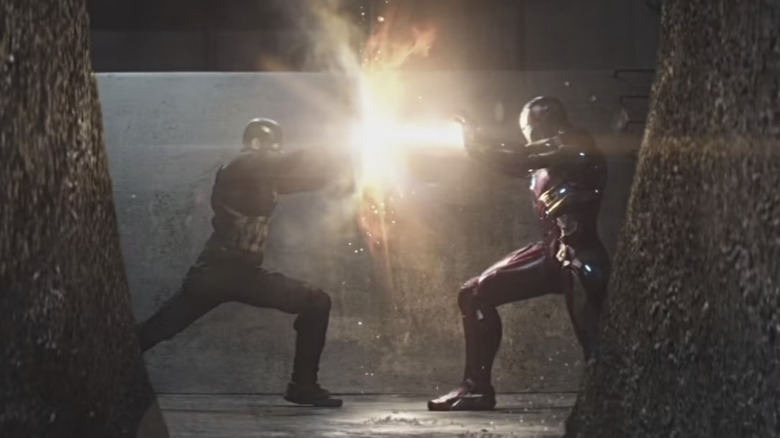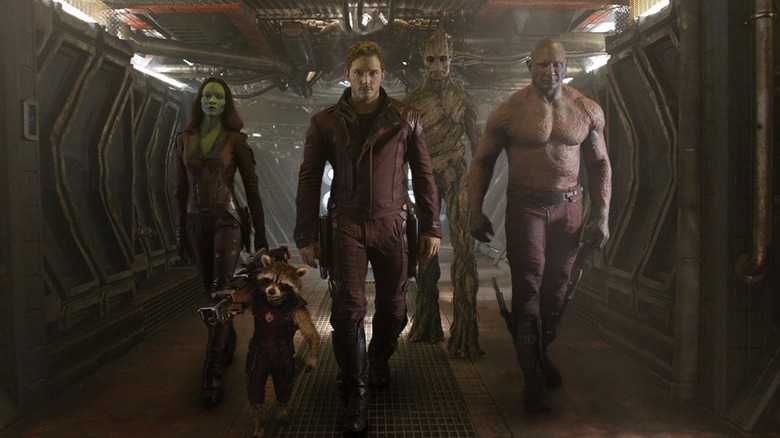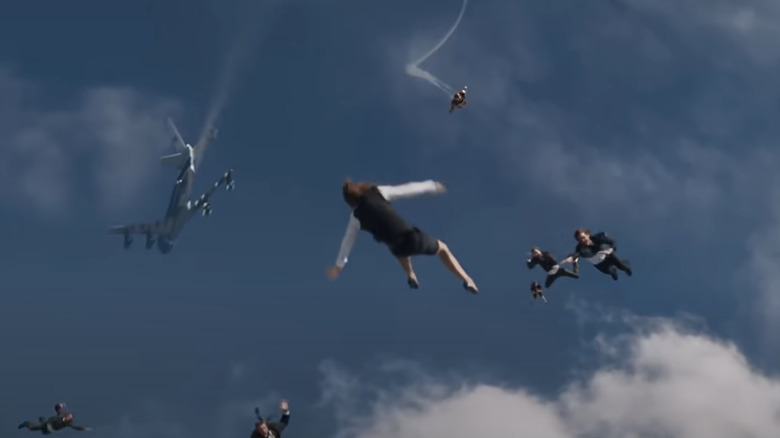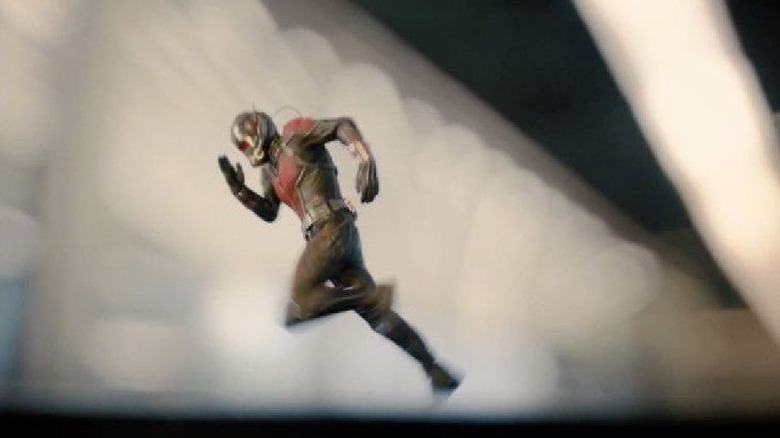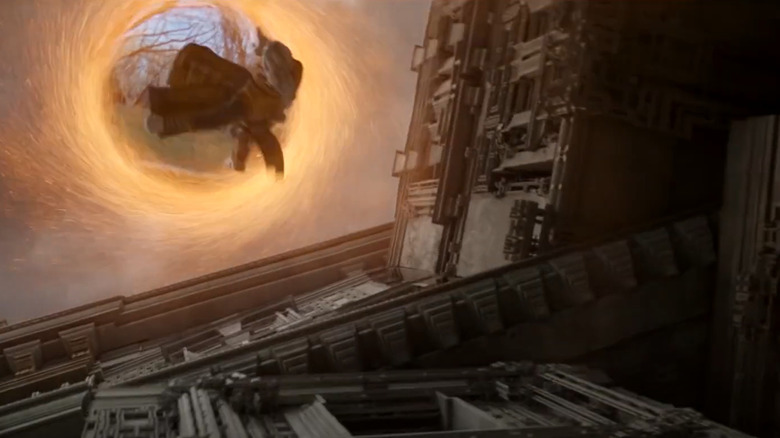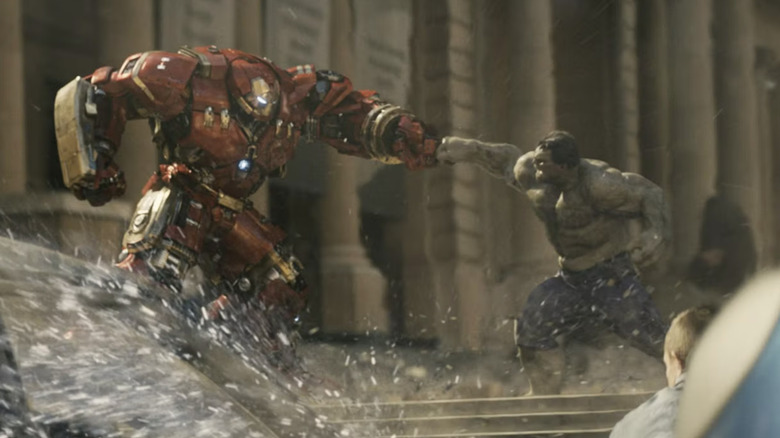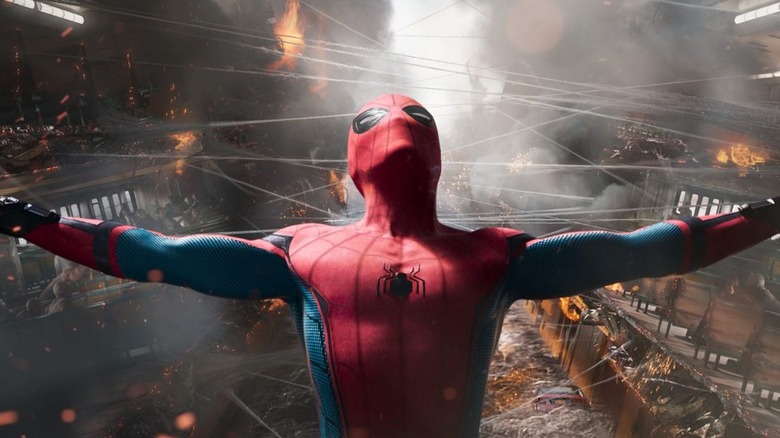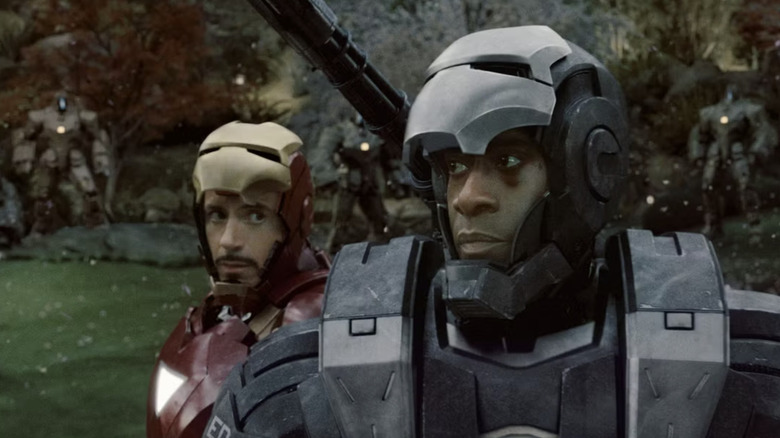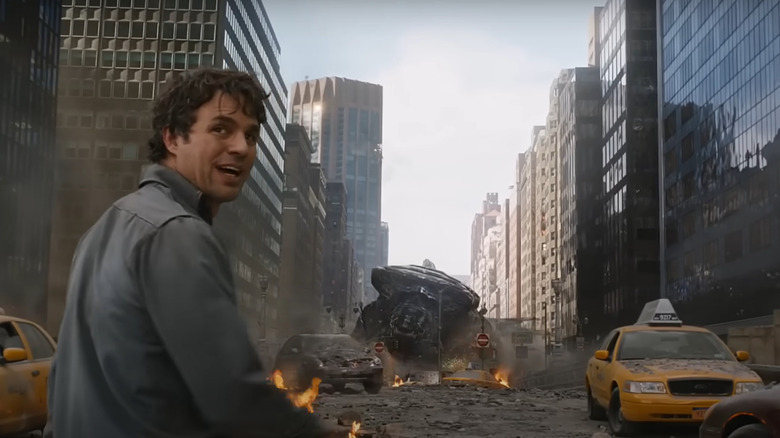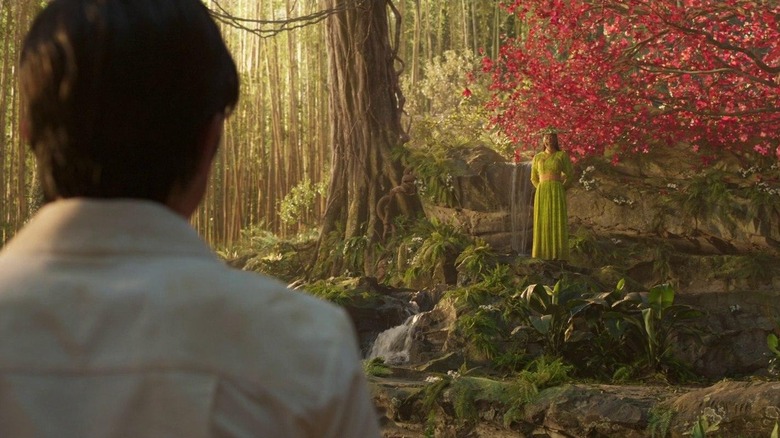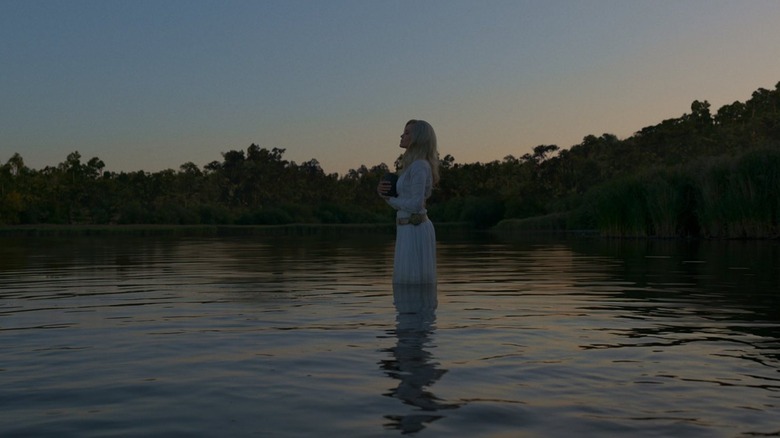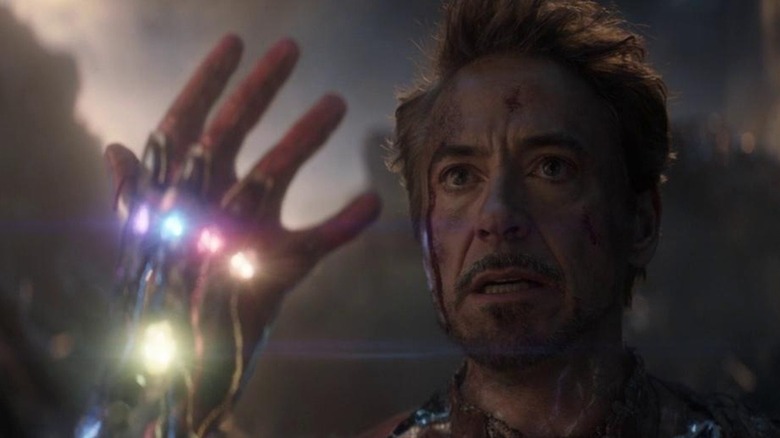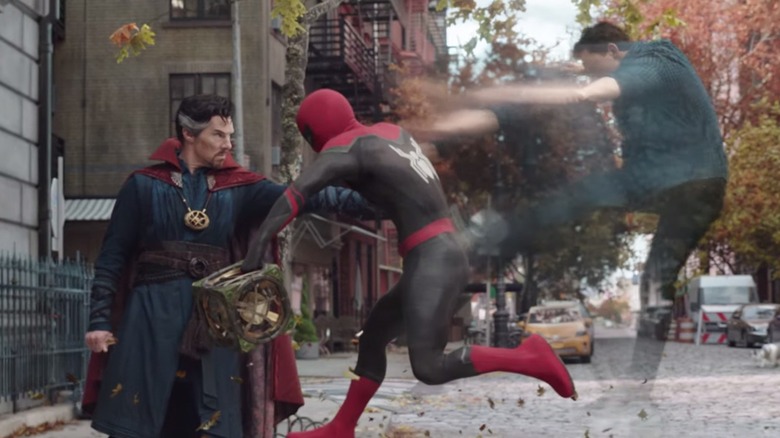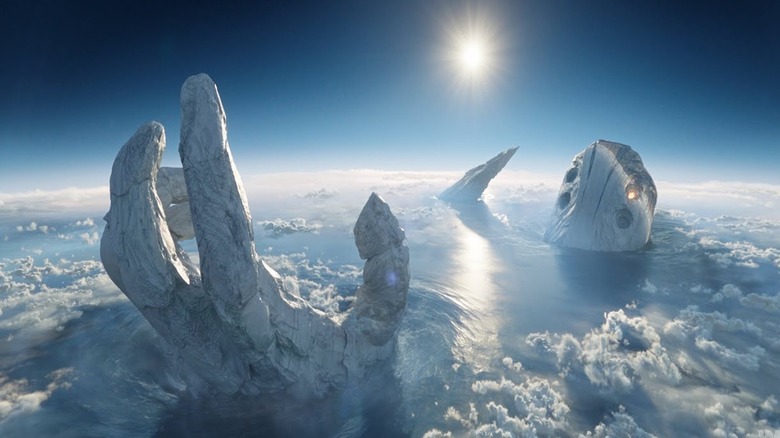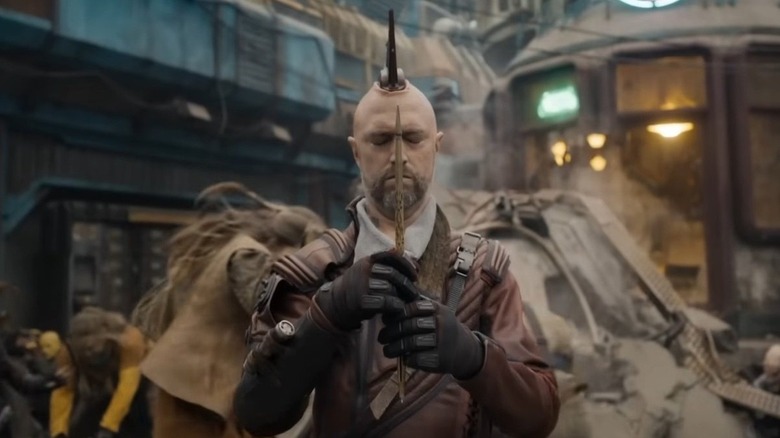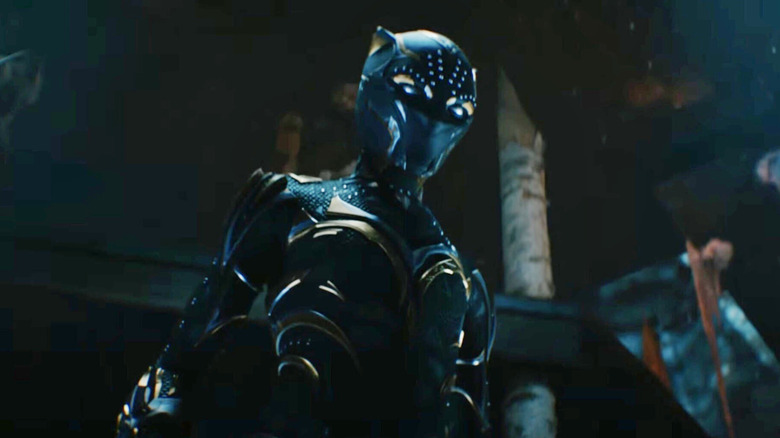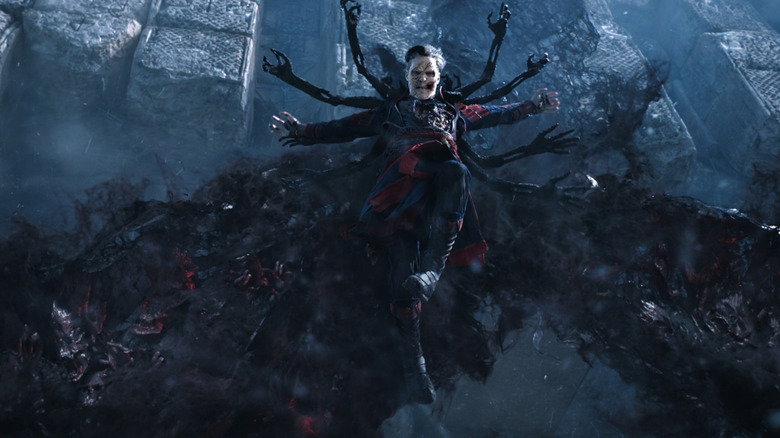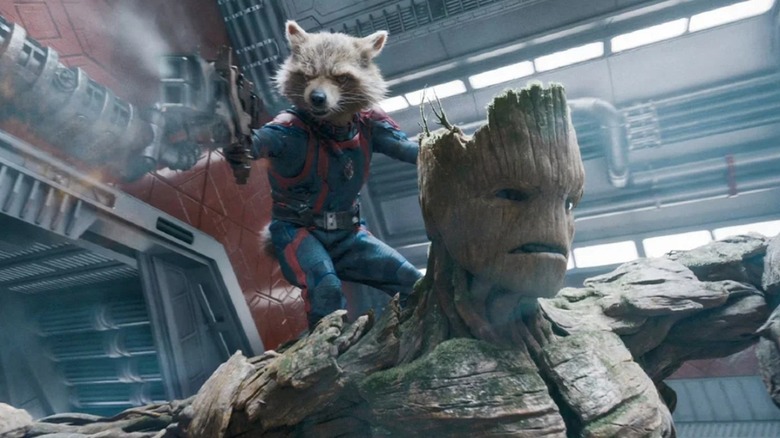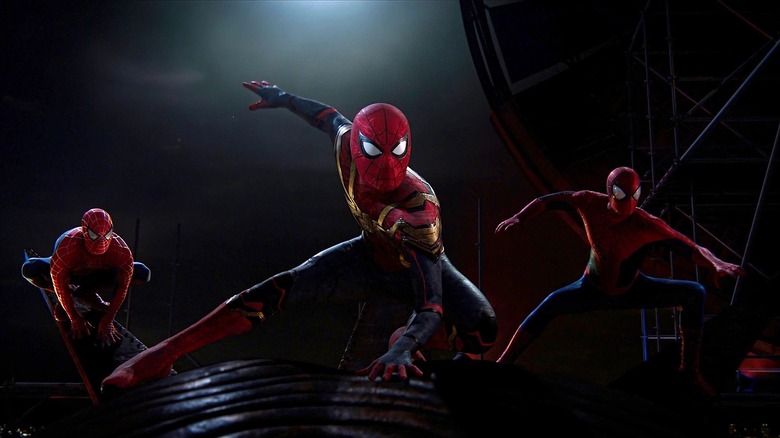The Most Epic Shots In Marvel Movies
As demonstrated by years of solid reviews and blockbuster box office grosses, there's an awful lot to love about the best Marvel movies. They've all got their share of funny one-liners, tons of high-stakes excitement, and even some good old-fashioned character development along the way — but really, when you get down to it, we're all turning out to be blown away by the most spectacular action that modern cinema has to offer.
Given all the amazing, mind-blowing camera work and CGI effects packed inside each and every Marvel movie, it's difficult to narrow it all down to a handful of shots can truly define the visual magnificence of the MCU. Difficult, but not impossible — and we've rounded up the senses-shattering scenes that prove it, narrowing every minute that makes up the studio's ever-growing list of blockbusters down to the 10 most epic shots in the entire Marvel Cinematic Universe.
The Avengers go into battle against Hydra (Avengers: Age of Ultron)
Considering how exhilarating the first "Avengers" movie's big tracking shot was, it's no surprise that Joss Whedon opted to double-dip and reuse the technique for the opening of "Avengers: Age of Ultron." Here, he takes the idea to its logical extremes, reserving the whole first minute of the film for a non-stop assault on the senses.
The camera moves at a rip-roaring pace, sweeping beside Black Widow (Scarlet Johansson) and Hawkeye (Jeremy Renner) before chasing after Thor (Chris Hemsworth), slowing for a brief moment only to rev back to life in hot pursuit of Captain America's (Chris Evans) motorcycle. It only goes on from there, in a shot that covers an entire CGI forest's worth of ground inside of sixty seconds. It's not just an impressive shot, it's a killer intro to each of the characters.
Without a single cut to break the flow, this shot introduces you to each Avenger as well as the abilities they bring to the team. Black Widow drives, punches, and shoots, Hawkeye fires off arrows, Hulk (Mark Ruffalo) smashes; it's a near-perfect blend of pure spectacle and visual character work. As icing on the cake, the shot even finishes with the whole team assembled, striking a pose together in mid-air, an homage to any number of Avengers comics covers. It's the ideal way to open up an "Avengers" movie and get the audience ready for two hours of high-octane, over-the-top action.
Iron Man and Captain America's fight (Captain America: Civil War)
Featuring a particularly awesome homage to the source material, this shot from "Captain America: Civil War: is ripped directly from the comics. And the best bit? The movie lets you know it's coming up, giving you a few precious moments to relish in anticipation. There's just no better shot to illustrate the movie's core conflict than that of the finale's epic shield-repulsor clash.
Before the money shot drops, a quick insert of Cap grabbing his shield is seen. Given that the music is already at its peak, this insert makes it clear that what's coming next is what the audience has been waiting for: the camera follows Steve Rogers as he charges toward Tony Stark (Robert Downey Jr.), deflecting each and every repulsor blast with his shield until the two foes are inches apart. Then the world slows to a crawl, isolating the visually stunning moment when Iron Man unleashes one final repulsor blast directly onto the surface of Cap's shield.
The blast reflects off the shield and blazes to life, filling the screen with a light that could only be achieved by the clash of this unstoppable force (Rogers) meeting the immovable object (Stark). There's no mystery why this shot is the defining image of the film it's representing — it fulfills everything we hoped this movie would be, all within a few frames.
The Guardians gather to save the galaxy (Guardians of the Galaxy)
In the last shot of this sequence, director James Gunn made it clear to us that he managed to assemble his own team of Avengers inside a movie of (previously) C-list Marvel heroes. With "Guardians of the Galaxy," Gunn crafted an action film that had heart and wit and made Groot (Vin Diesel) more than just a sentient tree, it made him a household name. This shot serves as the payoff to that accomplishment.
Just as we all cheered when the Avengers finally assembled in their historic rotating shot, this slow-mo dolly shot is epic, showing us this isn't your usual gang of heroes. The edit of each character joining in, looking annoyed or bored, or, in the case of Rocket (Bradley Cooper), tugging on a suit too tight around his junk, coupled with the angry '70s rock hit "Cherry Bomb," tells us this team is as far from the Avengers as you're going to get while still able to use the word "heroes."
Its gritty lighting and muted colors, in an otherwise colorful outer space world, gives us the sense our heroes are walking toward their doom. And, considering a couple of them are yawning, they're not too busted up about it.
Iron Man races to save Air Force One's crew (Iron Man 3)
The entire Air Force One rescue scene in "Iron Man 3" is downright incredible, so narrowing it down to a single shot was tough — but we've done it. While there are a multitude of winner-worthy examples of cinematography on display in this scene, one narrowly rises above the competition. It's the shot of Iron Man dashing down from a destroyed Air Force One to save its entire crew, immediately after being told by Jarvis that carrying them all would be an impossibility.
From a visual imagery perspective, the shot contains all the necessary elements: a smoking Air Force One in the distance, a crew of people screaming and flailing mid-free fall, and a tiny gold and red speck rocketing toward them to save the day. This shot does an impeccable job of conveying the stakes of the situation as well as the horror of it.
And it doesn't stop there: not only does the director's expert stage-blocking cram all of that information into a single shot's framing, but it does so while employing the shaky-cam technique, so viewers can get swept up in the free fall themselves. It's a touch that really sells the gravity (heh) of the situation, even if the audience isn't consciously aware of it. Couple all of that with Brian Tyler's eerie score ominously murmuring in the background, and it's an uncontested nail-biter of a shot, guaranteed to keep everyone on the edge of their seats.
Ant-Man hops over the firing pistol (Ant-Man)
This shot is epic if for no other reason than that it makes a character called "Ant-Man" look cooler than some of the A-list Avengers. Seriously, everything about this shot just screams "Holy crap!" What makes it so cool?
Maybe it's the kinetic energy of the camera sweeping beside Ant-Man (Paul Rudd) that makes the moment so special, tracking him as he runs on the surface of a gun immediately after dodging its bullet at (literal) point-blank range. Or maybe it's the fact that we just saw an ant-sized hero hop through a glass bullet hole seconds earlier only to end up on top of the pistol that created the hole in the first place.
It's that brand of absurdity that perfectly summarizes why the shot works: it revels in its craziness while also giving Scott Lang the heroic framing he deserves. And it doesn't hurt that the shot is also superbly paced, moving along at at a speed where our minds aren't allowed even a split-second to dwell on the ridiculousness of the sequence.
Kaecilius' first sling ring escape (Doctor Strange)
You can tell the director and storyboard artist had a fun time thinking up images for "Doctor Strange," including the kind of crazy, mind-bending shots that reaffirm why this movie needed to happen: to establish magic in the MCU and, perhaps, bring it back to cinemas at large.
The first thing to note about the shot is its paradoxical angling: it's simultaneously a low angle and high angle shot, with either definition working based on how you look at it. This subliminally reinforces one of the biggest themes in "Doctor Strange," that everything's just a matter of perspective. This, of course, is only one of a few super-interesting things going on with the shot.
The next thing to note is the color grading of the shot. It leaves the buildings a dull, desaturated grey divided only by pitch-black shadows, allowing us to A) perfectly track where the sorcerers are distorting geography and B) help us focus our attention on the mystical glowing elements, i.e., the sling ring portal. It's a prime example of masterful aesthetic design by director Scott Derrickson. And, on the topic of aesthetics, this shot really is a special one: it's ridiculously busy yet also super focused, allowing us to be overwhelmed by the buildings consuming themselves in the background while still letting us remain fully concentrated on Kaecilius' (Mads Mikkelsen) sling ring escape.
The big punch between Hulk and the Hulkbuster (Avengers: Age of Ultron)
This one made the list for pretty obvious reasons. The Hulk vs. Hulkbuster fight instantly became one of the most anticipated MCU throwdowns of all time when the first "Avengers: Age of Ultron" trailer dropped, and the hype was well warranted. This shot had some close competition with other great bits from the ruckus, such as the initial assembly of the Hulkbuster and Hulk pummeling Stark up a tower, but we feel this one really captures the most epic moment.
After minutes of heated conflict where the upper hand flip-flops between Hulk and Iron Man in his Hulkbuster suit, the ultimate stalemate is reached when green fist meets robot fist, creating a blast wave that breaks glass and sends people flying. It's as intense as punches come and is captured at an extra wide angle that really helps translate the enormity of the two titans clashing. Not only is it a very cool shot on a technical level, but for Marvel fans, it's just such an amazing sight to see Hulk and Iron Man going at it on the big screen.
Spider-Man holds the ferry together (Spider-Man: Homecoming)
This is the quintessential hero shot, with a protagonist challenging impossible odds head-on in order to save the day. There's nothing quite as epic as seeing teen hero Spider-Man (Tom Holland) in "Spider-Man: Homecoming," desperately clutching to his webs to keep the Staten Island Ferry and all of its passengers from drowning. It's an epic shot that aptly summarizes the Spider-Man ethos — one of determination even in the absence of hope. In that sense, the shot flawlessly captures the essence of this Peter Parker and helps define this movie's take on the character.
Furthermore, if you look in the background of the shot, you'll notice a nice touch: the Statue of Liberty. Not only is it an iconic landmark that helps remind us just how high-profile the situation is, but it's also a monument representative of people who fought in the service of securing a better, safer tomorrow. It's a subtle reinforcement of Spider-Man's struggle, dangling between tons of sinking steel to try and keep everyone alive. This symbolism reminds us that Spidey is always in it for the greater good, which is why he's one of the greatest heroes.
Hammer drones surround Iron Man and War Machine (Iron Man 2)
This shot from "Iron Man 2" flawlessly sums up why Iron Man and War Machine (Don Cheadle) are so cool: they're just as ready to rumble as the audience watching them. Though the shot itself isn't very complex, its simplicity is one of its biggest selling points. The uncomplicated framing does a fine job of setting the scene for the fight, illustrating all key information via a slow, methodical rotation.
The motion of the camera helps to capture the predatory nature of the conflict, with the Hammer drones surrounding their prey at all angles like a pack of wolves would. Yet that's what makes our first point stand out even more: even though Tony and Rhodey are the ones standing at the heart of the death ring, they're not one bit worried. It's an epic shot that shows both Iron Men are ready to assume the mantle of being superheroes.
It's also a great lead-in to the action: it's a downtempo moment that visually illustrates the enemy's superior quantity and helps foreshadow that the big fight is only moments away, thanks to a plodding drum beat that escalates in perfect accordance with audience anticipation. Add in the remarkably gritty color palette and lighting choices that help set the mood for the upcoming fight, and this is a shot that's got all the ingredients for a badass finale setup.
Bruce Banner's 'I'm always angry' moment (The Avengers)
We had to put this one on our list. After all, it's likely the moment when most of us realized the MCU was finally becoming the cinematic juggernaut its studio's architects always knew it would be. The "That's my secret, Cap" shot from "The Avengers" is not only the most iconic moment for the MCU's Hulk but also for the entire Marvel Cinematic Universe as a whole.
It's the direct lead-in to the Avengers finally assembling, after five movies' worth of buildup. It's simultaneously an intensely personal character-building moment as well as an "oh my god" moment for the audiences who've just realized that Marvel cracked the code to making epic superhero movies. When people think back to "The Avengers," they think about this shot and the bevy of amazing scenes that follow it.
Literally everything about this shot works: Alan Silvestri's theme building in the background, Mark Ruffalo's expert line delivery, and the shot's perfect length all capitalize on the audience's expectation for some Hulk-smashing. But the framing of the shot itself communicates its point. Even though there's a massive alien heading toward a shrimpy Bruce Banner, the incoming CGI spectacle is placed in the background while Ruffalo remains alone in the fore. This reminds us that the true emphasis will never be on the spectacle, but rather on the characters that help facilitate it. And that's the MCU's secret, Cap: it's always focused ... on the superheroes.
Captain America faces down Thanos' army alone (Avengers: Endgame)
Captain America is the center of several great images in the spectacular third act of "Avengers: Endgame," including that iconic shot of him wielding Mjolnir or the tender final close-up of Steve Rogers finally sharing a dance with Peggy Carter (Hayley Atwell). The greatest shot of him in the entirety of "Endgame," though, is a striking wide shot depicting Steve standing alone amidst the ruins of Avengers HQ, ready to face down Thanos (Josh Brolin) and his massive multiversal army.
This gargantuan image captures the very essence of Steve Rogers: he's a little guy willing to stand up to bullies no matter how big they are. Even with the other Avengers M.I.A. at that moment, Steve doesn't back down from a fight. Placing him alone on the left side of the frame while Thanos and his minions gather on the image's right side vividly visualizes that aspect of Cap's personality.
This shot also has some lovely subtle touches, like putting Thanos in the foreground with Steve (an indication of him being the most important adversary in the scene) and having the sole source of natural light hover above Steve, offering a glimmer of hope in what could be a brutally bleak image. Everything seems dark, but Steve is here to provide light in that darkness. As long as he's still standing, there's hope for human civilization. Such is the underlying meaning of this tableau, which also functions as a thesis statement for Captain America.
Wenwu first encounters his future wife (Shang-Chi and the Legend of the Ten Rings)
Director Destin Daniel Cretton and cinematographer William Pope gave "Shang-Chi and the Legend of the Ten Rings" a welcome dose of grandiose imagery and crisply filmed fight scenes largely absent from MCU's previous three phases. That was especially apparent in a prologue depicting immortal criminal legend Xu Wenwu (Tony Leung) first encountering his future wife Ying Li (Fala Chen) while searching for mystical village Ta Lo.
This wide shot depicting the two characters meeting is a magnificent image, especially in its sense of depth. Many MCU films deploy tight framing that doesn't suggest many layers of activity. In contrast, this image places Wenwu in the foreground, a masked Ying Li in the background, and further foliage like a cherry blossom tree even deeper into the frame's backdrop.
This level of depth subtly communicates how Wenwu has stumbled into a vast domain that not even he can fully contend with. Meanwhile, the bright pinks hovering around Ying Li are especially pleasing to the eye, as is the bright shade of green in her dress that immediately separates her from the darker green of the plants in the shot. Ying Li's high positioning in the image instantly conveys her immense level of power and authority, a hint of the duel between these tremendous figures that's about to unfold. This early "Shang-Chi" image is beautiful on its own while effectively communicating the entire film's bold visual tendencies.
Thena stands in the lake (Eternals)
Before she directed the $200+ million Marvel Studios film "Eternals," director Chloe Zhao was a master of intimate features set in rural America that often blurred the lines between fictional and non-fictional cinema. Titles like "Songs My Brothers Taught Me," "The Rider," and "Nomadland" were modern classics that thrived on very intimate, naturalistic imagery.
Zhao and go-to MCU cinematographer Ben Davis channel the vibes of those earlier Zhao works for a deeply evocative image in "Eternals" of Thena (Angelina Jolie) standing in the middle of a lake, preparing to dispel the ashes of fallen Eternal Gilgamesh (Don Lee). Jolie is in the center of the shot, which makes use of natural backdrops and lighting. Captured against the faintest signs of a sunrise, the traces of yellow peppered in the blue sky behind her are utterly gorgeous.
The water Thena is standing in reflects the sky's complicated color scheme, poignantly mirroring the swirling, overwhelming emotions in her soul as she bids farewell to a dear friend. The slight upward tilt of Jolie's head and her withdrawn body language, especially with no other figures in sight, achingly capture her turmoil and loneliness. Some MCU shots are epic because of their callbacks to classic comic book images. This shot, with its epic sense of palpable emotion, could have come from one of Zhao's earliest features.
Tony Stark wielding the Infinity Stones (Avengers: Endgame)
"it's like poetry, it rhymes." So said George Lucas about various parallels across the original six "Star Wars" films. The folks behind "Avengers: Endgame" took that to heart for the unforgettable shot of Tony Stark wielding those Infinity Stones and preparing to destroy Thanos once and for all. Specifically, that close-up of Tony echoes a similar image from the end of "Iron Man," in which he declares to the world, "I am Iron Man." Both feature tight framing and the camera subtly pulling in toward Tony as he utters the same phrase.
In "Iron Man," however, Tony's face is rife with self-satisfied glee as he breaks the rules and injects anarchy into people's expectations. For the moment in "Avengers: Endgame," he's once again upending calculated outcomes, this time for Thanos. But the darker color scheme of the image (save for the pulsating bright hues from the Infinity Stones) and Stark's battered face make it apparent that this is a nobler gesture on Stark's part. This isn't about accentuating his grandiose bad boy image, but rather making a better world for the people of tomorrow.
The innate tightness of the framing means there's nothing to distract viewers from Tony's selfless sacrifice in this defining moment of his life and the "Avengers" saga. Even beyond how it plays off a previous climactic "Iron Man" image, this is still a stirring visual chock-full of emotion and excitement.
Doctor Strange knocks Peter Parker's soul out of Spider-Man (Spider-Man: No Way Home)
Initially allies in the previous two "Avengers" movies, Peter Parker and Doctor Strange (Benedict Cumberbatch) eventually come to blows in "Spider-Man: No Way Home" over how to handle the various displaced multiversal "Spider-Man" baddies that have appeared in the MCU. As the duo struggle over a mystical MacGuffin, Strange unleashes a trick that The Ancient One (Tilda Swinton) previously used on him in the original "Doctor Strange" and kicks Peter's soul out of his body.
In a wide shot echoing a similar image from "Doctor Strange," the Sorcerer Supreme uses a few precisely-placed fingers to push Parker's aura out of his fleshy vessel. It's not the first callback to this shot in the MCU, but having Holland's Parker persona shown exiting a fully-costumed Spider-Man adds an extra layer of personality to the "No Way Home" version.
It's also great that this image feels like it could easily translate to the world of comic book splash panels. Rarely do the MCU movies directly evoke comic book imagery like Ang Lee's "Hulk" or the two "Spider-Verse" masterpieces did. Granted, these comic book influences show up for just one shot, but it's lovely seeing "No Way Home" combine two MCU staples in a dynamite shot harkening back to those grandiose splash pages.
Tiamut frozen in the ocean (Eternals)
The climax of "Eternals" is a gargantuan piece of spectacle-driven filmmaking involving an active volcano, tons of Eternals unleashing their CG-realized superpowers, and the ticking clock of a Celestial emerging from the ocean. It all gets too big for its own good, with character beats and the film's more subversive previous impulses getting lost in the shuffle. But Chloe Zhao and Ben Davis still deliver a handful of fun images, particularly the stunning shot of Tiamut frozen in the ocean.
The Eternals stop this titanic entity from fully emerging, but most of his head and one of his hands are still permanently poking out of the Earth. The camera pulls back to emphasize the sheer scale of this new status quo, with clouds swirling around these monolithic appendages. The crisp, fully coherent framing makes the scope of this outcome staggeringly, beautifully clear.
Meanwhile, placing a bright sun in this shot emphasizes how this Celestial is now part of the "new normal" for people. This is just an "ordinary" sunny day that happens to feature a godlike being protruding from the ocean. Detailed touches, like one of Tiamut's eyes glistening with a golden hue, further make this unforgettable shot the most visually evocative of the various artistically erratic detours that "Eternals" takes.
Kraglin preparing to unleash his arrow (Guardians of the Galaxy Vol. 3)
As Knowhere comes under attack from the High Evolutionary (Chukwudi Iwuji) and his forces in "Guardians of the Galaxy Vol. 3," its inhabitants begin scrambling. However, in the middle of all this bedlam, director James Gunn and cinematographer Henry Braham zero the camera in on Kraglin (Sean Gunn) standing still, closing his eyes, and concentrating on controlling Yondu's (Michael Rooker) arrow. The decision to plop a perfectly calm Kraglin in the middle of a frame where various colorful aliens are panicking in the background already distinguishes this image. The contrast between the background and foreground immediately grabs one's attention, while pausing the action-packed "Vol. 3" climax for something so intimate and slower-paced makes the shot extra noticeable.
There's also commendably precise blocking in this sequence, with both Kraglin's clutching of the arrow and the big pointy fin on his head exactly in the center of the frame. This symmetry in a scene rife with chaos immediately grabs any viewer's attention. Plus, Kraglin, as seen in previous "Guardians of the Galaxy" installments, is not a bad guy, but a scraggly, imperfect space pirate and distinctly ordinary person navigating out-of-control situations. This subtly dense "Vol. 3" visual provides him with a sense of maturity and control that would have been unthinkable in the first "Guardians of the Galaxy" movie.
Shuri emerges as the Black Panther (Black Panther: Wakanda Forever)
In 2018's "Black Panther," audiences first witness T'Challa/Black Panther (Chadwick Boseman) plunge fully costumed from a Wakandan aircraft onto an isolated road below. For Shuri's (Letitia Wright) grand entrance in the Black Panther armor in 2022's "Black Panther: Wakanda Forever," following the untimely passing of her brother, the theatricality of having a Black Panther plunge to Earth from a great height is once again employed.
This time, however, director Ryan Coogler and cinematographer Autumn Durald Arkapaw capture this moment in an unbroken low-angle shot situated on the ground rather than following the falling Black Panther from the sky. This already instills a sense of distinctiveness to Shuri's entrance, while the positioning of the camera lets Shuri exude a sense of authority. Tilted upward, the camera innately lends her a towering presence.
This angle also allows viewers to appreciate the finer details separating this new Black Panther armor from the one T'Challa wore, including yellow highlights and white dots adorning the costume's top half. Above all else, the image carries a quiet sense of majesty befitting the significance of this woman latching onto this superhero identity. True, Shuri's debut in the Black Panther suit is rooted in a callback to the past. But this striking introduction in "Wakanda Forever" exudes plenty of personality exclusive to Shuri picking up the mantle.
Undead Doctor Strange unfolds his many hands (Doctor Strange in the Multiverse of Madness)
Once Doctor Strange hops into the body of an undead variant of himself, "Doctor Strange in the Multiverse of Madness" director Sam Raimi really comes alive. A veteran of both the horror-comedy genre and the original "Spider-Man" movies, Raimi is clearly having a ball executing this concept with theatrical panache, including a clap of thunder going off in the background as this undead hero rises. Once this version of Strange is up and running, an especially excellent shot (understandably featured heavily in the "Multiverse of Madness" marketing campaign) unfolds in which Strange uses various black-colored Souls of the Damned to his advantage.
As he rises into the air, Strange unfurls his crumbling hands and the Souls of the Damned similarly unfold their hands in tandem. It now looks like Strange has a multitude of supernatural powers on his side to fight Scarlet Witch (Elizabeth Olsen) with. This visual is so excitingly kooky (not to mention unabashedly outlandish) that it can't help but register as one of the MCU's most riotous shots. The contrasts between the red scattered throughout Strange's costume, the black colors of the Souls, and the light blue backdrop also provide an interestingly varied color scheme for this preposterous moment.
Raimi's dedication to realizing the ridiculous in his career means this image is also executed with nary a hint of irony. The prowess of both Raimi's imagination and the most ludicrous Marvel Comics imagery came to vivid life in this "Multiverse of Madness" shot.
That one-take fight scene (Guardians of the Galaxy Vol. 3)
Once the Guardians of the Galaxy fully reunite after saving Rocket in the film's third act, "Guardians of the Galaxy Vol. 3" decides it's time to celebrate by delivering a frenetic action sequence that showcases the group working together to defeat baddies. So begins an extended one-take fight scene in a colorful, outer space hallway, set to the Beastie Boys track "No Sleep Till Brooklyn." A parallel to the even better mixture of toe-tapping music and extreme carnage dished out in the "Come A Little Bit Closer" sequence in "Guardians of the Galaxy Vol. 2," this scene contains one of the lengthiest shots in the entire MCU.
The quick cuts dominating many fight scenes in this franchise (particularly when it comes to Phase One or Two entries) are discarded here as director James Gunn, now a veteran of helming blockbuster movies, opts for an unblinking rendering of a superhero team fighting together.
The result is a riveting set piece packing plenty of entertainment and great fight choreography in just one shot. Rocket's ability to scramble up and down various surfaces (including the body of Groot) like a real raccoon is especially fun to witness. It's also terrific how much the individual personalities of the various Guardians materialize here, such as Nebula's (Karen Gillan) very flexible limbs. Delivering character beats, tremendously involving skirmishes, and visual confidence, this "Vol. 3" shot is a wonder to behold.
A trio of Spideys assemble (Spider-Man: No Way Home)
When Andrew Garfield took over as Peter Parker/Spider-Man in 2012's "The Amazing Spider-Man," that seemed to signal the end of Tobey Maguire's Spidey once and for all. No two live-action Spider-Men could exist at once in theaters. Tom Holland kicking off his reign as the web-crawler in 2016's "Captain America: Civil War" signaled a similar conclusion for Garfield's incarnation of the character. But all those rules got shattered into a thousand fragile pieces with the multiversal 2021 adventure "Spider-Man: No Way Home."
Here, Holland, Garfield, and Maguire's versions of these characters all congregate in one big blockbuster. The result was a film rife with crowdpleasing moments that lent new weight to Peter embracing his Spider-Man persona. It also inspired one of the MCU's most staggeringly cool images, depicting the three versions of Spider-Man plopping down together in one frame.
The framing of this scene, which gives equal visual weight to all three Spideys, really makes it fun to observe the costume variations across each iteration. The varying poses are also a great way to reflect their individual personalities, while the fact that they're lined up front to back in reverse-chronological order is another lovely little touch. The concept of seeing so many Spider-Men in one live-action movie felt impossible for so long, but this unforgettable "No Way Home" shot made the unthinkable into a glee-inducing reality.
